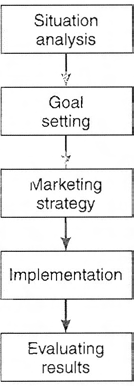CHAPTER 2
UNDERSTANDING AND APPROACHING THE MARKET
REFERENCES
1.
Alvin A. Achenbaulll , "Advertising Doesn't Manipulate Con-
10. RonaJd Frank, William Massey, and Yoram Wind, Market Segmen-
sumerism," Journal of Advenising Research, April 1972, p. 7.
tation, Englewood Cliffs, N.J.: Prentice-Hall, 1972.
2.
B. Charles Ames and James D. Hlavacek, Managing Marketing for
II. Martha Farnsworth, "Psychographies for the 1990s," American Demo-
Industrial Firms, New York , N.Y.: Random House, pp. 96- 103.
graphics, July 1989, pp. 25, 28-30.
3.
Ames, p. 102.
12. H.H. Kassarjian , "Personality and Consumer Behavior: A Review,"
4.
Betsy D. Belb, "Discovering the 65+ Consumer," Business Horizons,
Journal of Marketing Research, Vol. 8, November 197 I .
M ay-J une 1982, pp. 42-46.
13. William D. Wells, "Psychographies: A Critical Review," Journal 0/
5.
Alfred S. Boote, "Market Segmentation by Personal Values and
Marketing Research, May 1975, pp. 196-213.
Salient Product Attributes," Joumal ofAdvertisi,lg Research, Vol. 21,
14. Joseph T. Plummer, "The Concept and Application of Life Sty le Seg-
No. I, February 198 I , pp. 29- 35.
mentation," Journal o/Marketing , January 1974, p. 33.
6.
Kenneth Boulding, Economic Analysis, New York, N.Y.: Harper &
15. David J. Reibstein, Christopher H. Lovelock, and Ricardo de P. Dob-
Row, Inc, 1995, pp. 608- 615.
son, "The Direction of Causality Between Perceptions, Affect, and
7.
William R. Darden, w.A. French, and RD. Howell, "Mapping Mar-
Behavior: An Application to Travel Behavior," Journal of Consumer
ket Mobility: Psychographic Proliles and Media Exposure," Journal
Research, Vol 6., March 1980, pp. 370-376.
of Business Research, Vol. 7, No.8, 1979, pp. 51-74.
16. Benson P. Shapiro and Thomas Y. Bonoma, "How to Segment Indus-
8.
Duane L. Davis and Ronald S. Rubin, "Identifying the Energy-
trial Markets ," Harvard Business Review, May-June 1984, pp.
Conscious Consumer: T he Case of the Opinion Leader," Journal of
104-110.
the Academv of Marketing Science, Spring 1983, p. 185.
9.
Ten-y Elrod and Russel S. Winer, "An Empirical Evaluation of Aggre-
gation Approaches for Developing Market Segments," Joumal ofMar-
keiing Vol. 46, No.4 , Fall 1982, pp.32-34.
C HAPTER3
MARKETING RESEARCH: AN AID TO
DECISION MAKING
LEARNING O BJ EC T IV ES
Having completed this chapte r, you should '
•
Understand the role of marketing research .
•
Understand the marketing research process and the techniques
employed .
DISCOVERING WHY THE Y C HEW
JUiCY Fruit Gum, the oldest brand of the Wm. Wrigley Jr. Company, wasn't chew-
ing up the teen market, gum's top demographic. In 1997, the company found itself under
pressure from competitors. Sales and market share were down . How could Wrigley make
more kids chomp on Juicy Fruit?
What qualities about Juicy Fruit might appeal to teens? Wrigley went to the source
to find out. It found kids who chew five sticks or more of Juicy Fruit each week and
promptly gave them a homework assignment. Find pictures that remind them of the gum
and write a short story about it. From the focus group, Wrigley learned that teens chew
Juicy Fruit because it's sweet. It refreshes and energizes them.
Their ad agency, BBDO, confirmed what the teens were say ing . BBDO asked
more than 400 heavy gum chewers to rate various brands by attributes that best repre-
sented them. For Juicy Fruit, respondents picked phrases such as "has the right amount
of sweetness" and "is made with natural sweetness."
Another study by BBDO looked into why tee ns chew gum. Was it because they 're
stressed out-or because they forgot to brush their teeth before going to school? Nearly
three out of four kids said they stick a wad into their mouth when they crave something
sweet. And Juicy Fruit was the top brand they chose to fulfill that need (Big Red was a
distant second).
Sources: "How Sweet It Is," American Demog raphics, March 2000, p, S 18; "Flavor du Jour," American Demog raphics, March 2000, p, S I 0; Erika Ra smusso n, "Cool for Sale," Sales & Marketing Management , March 1998, pp. 20-22, INTRODUCTION
Although the marketing research conducted by the Wrigley Co. was fairly simple, it pro-
vided a new direcLion for their marketing strategy. BBDO developed four TV commercials
53


54





